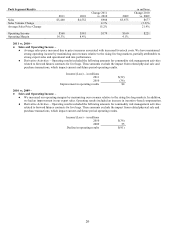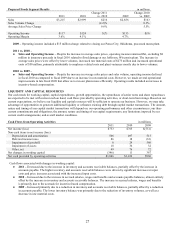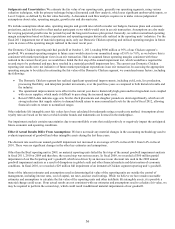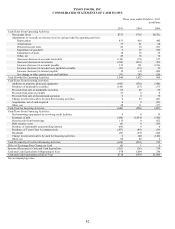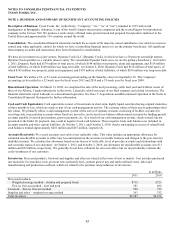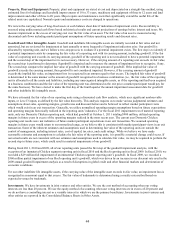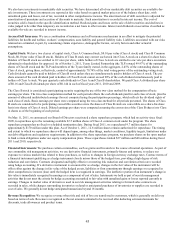Tyson Foods 2011 Annual Report Download - page 35
Download and view the complete annual report
Please find page 35 of the 2011 Tyson Foods annual report below. You can navigate through the pages in the report by either clicking on the pages listed below, or by using the keyword search tool below to find specific information within the annual report.
35
Description
Judgments and Uncertainties
Effect if Actual Results Differ From
Assumptions
Income taxes
We estimate total income tax expense
based on statutory tax rates and tax
planning opportunities available to us in
various jurisdictions in which we earn
income.
Federal income tax includes an estimate
for taxes on earnings of foreign
subsidiaries expected to be remitted to
the United States and be taxable, but
not for earnings considered indefinitely
invested in the foreign subsidiary.
Deferred income taxes are recognized
for the future tax effects of temporary
differences between financial and
income tax reporting using tax rates in
effect for the years in which the
differences are expected to reverse.
Valuation allowances are recorded
when it is likely a tax benefit will not
be realized for a deferred tax asset.
We record unrecognized tax benefit
liabilities for known or anticipated tax
issues based on our analysis of whether,
and the extent to which, additional
taxes will be due.
Changes in tax laws and rates could
affect recorded deferred tax assets and
liabilities in the future.
Changes in projected future earnings
could affect the recorded valuation
allowances in the future.
Our calculations related to income
taxes contain uncertainties due to
judgment used to calculate tax
liabilities in the application of complex
tax regulations across the tax
jurisdictions where we operate.
Our analysis of unrecognized tax
benefits contains uncertainties based on
judgment used to apply the more likely
than not recognition and measurement
thresholds.
We do not believe there is a reasonable
likelihood there will be a material
change in the tax related balances or
valuation allowances. However, due to
the complexity of some of these
uncertainties, the ultimate resolution
may result in a payment that is
materially different from the current
estimate of the tax liabilities.
To the extent we prevail in matters for
which unrecognized tax benefit
liabilities have been established, or are
required to pay amounts in excess of
our recorded unrecognized tax benefit
liabilities, our effective tax rate in a
given financial statement period could
be materially affected. An unfavorable
tax settlement would require use of our
cash and generally result in an increase
in our effective tax rate in the period of
resolution. A favorable tax settlement
would generally be recognized as a
reduction in our effective tax rate in the
period of resolution.
Impairment of goodwill and other intangible assets
Description: Goodwill impairment is determined using a two-step process. The first step is to identify if a potential impairment exists
by comparing the fair value of a reporting unit with its carrying amount, including goodwill. If the fair value of a reporting unit
exceeds its carrying amount, goodwill of the reporting unit is not considered to have a potential impairment and the second step of the
impairment test is not necessary. However, if the carrying amount of a reporting unit exceeds its fair value, the second step is
performed to determine if goodwill is impaired and to measure the amount of impairment loss to recognize, if any.
The second step compares the implied fair value of goodwill with the carrying amount of goodwill. If the implied fair value of
goodwill exceeds the carrying amount, then goodwill is not considered impaired. However, if the carrying amount of goodwill
exceeds the implied fair value, an impairment loss is recognized in an amount equal to that excess.
The implied fair value of goodwill is determined in the same manner as the amount of goodwill recognized in a business combination
(i.e., the fair value of the reporting unit is allocated to all the assets and liabilities, including any unrecognized intangible assets, as if
the reporting unit had been acquired in a business combination and the fair value of the reporting unit was determined as the exit price
a market participant would pay for the same business).
For other indefinite life intangible assets, if the carrying value of the intangible asset exceeds its fair value, an impairment loss is
recognized in an amount equal to that excess.
We have elected to make the first day of the fourth quarter the annual impairment assessment date for goodwill and other indefinite
life intangible assets. However, we could be required to evaluate the recoverability of goodwill and other indefinite life intangible
assets prior to the required annual assessment if, among other things, we experience disruptions to the business, unexpected significant
declines in operating results, divestiture of a significant component of the business or a sustained decline in market capitalization.



